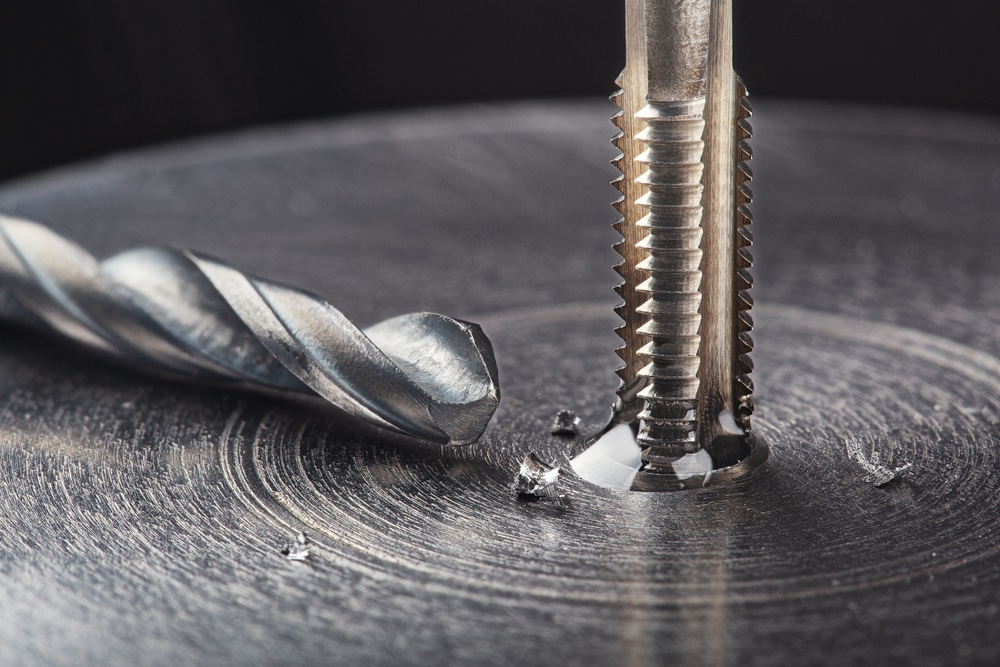Mon.: 8:00am–4:00pm
Tue.: 8:00am–4:00pm
Wed.: 8:00am–4:00pm
Thu.: 8:00am–4:00pm
Fri.: 8:00am–12: 00pm
Sat.: Closed
Sun.: Closed
-
450-217-0778
- [email protected]

In many fields of engineering and manufacturing, manual threading and drilling remain essential skills, even in an age of advanced CNC machining. Whether you’re in the shop or on-site, knowing how to correctly drill and thread by hand can ensure precision and reliability, especially for custom or repair work.
Imperial coarse
Imperial Tap Size | Thread Pitch (TPI) | Tap Drill Size (Decimal Inches) | Closest Drill Size |
4-40 | 40.0 | 0.089 | No. 43 |
6-32 | 32.0 | 0.1065 | No. 36 |
8-32 | 32.0 | 0.136 | No. 29 |
10-24 | 24.0 | 0.1495 | No. 25 |
1/4-20 | 20.0 | 0.201 | No. 7 |
5/16-18 | 18.0 | 0.257 | Letter F |
3/8-16 | 16.0 | 0.3125 | 5/16″ |
7/16-14 | 14.0 | 0.368 | Letter U |
1/2-13 | 13.0 | 0.4219 | 27/64″ |
9/16-12 | 12.0 | 0.4844 | Letter W |
5/8-11 | 11.0 | 0.5313 | 17/32″ |
3/4-10 | 10.0 | 0.6563 | 21/32″ |
7/8-9 | 9.0 | 0.7656 | 49/64″ |
1″-8 | 8.0 | 0.8594 | 55/64″ |
1-1/8″-7 | 7.0 | 0.9844 | 63/64″ |
1-1/4″-7 | 7.0 | 1.1094 | 1-7/64″ |
1-3/8″-6 | 6.0 | 1.2344 | 1-15/64″ |
1-1/2″-6 | 6.0 | 1.3594 | 1-23/64″ |
1-3/4″-5 | 5.0 | 1.4844 | 1-31/64″ |
2″-4.5 | 4.5 | 1.7344 | 1-47/64″ |
Imperial Fine
Imperial Tap Size | Thread Pitch (TPI) | Tap Drill Size (Decimal Inches) | Closest Drill Size |
4-48 | 48 | 0.086 | No. 45 |
6-40 | 40 | 0.099 | No. 39 |
8-36 | 36 | 0.12 | No. 31 |
10-32 | 32 | 0.159 | No. 21 |
1/4-28 | 28 | 0.213 | No. 3 |
5/16-24 | 24 | 0.272 | Letter I |
3/8-24 | 24 | 0.3125 | 5/16″ |
7/16-20 | 20 | 0.368 | Letter U |
1/2-20 | 20 | 0.4531 | 29/64″ |
9/16-18 | 18 | 0.4844 | Letter W |
5/8-18 | 18 | 0.5469 | 35/64″ |
3/4-16 | 16 | 0.6563 | 21/32″ |
7/8-14 | 14 | 0.7656 | 49/64″ |
1″-14 | 14 | 0.8594 | 55/64″ |
1-1/8″-12 | 12 | 0.9844 | 63/64″ |
1-1/4″-12 | 12 | 1.1094 | 1-7/64″ |
1-3/8″-12 | 12 | 1.2344 | 1-15/64″ |
1-1/2″-12 | 12 | 1.3594 | 1-23/64″ |
1-3/4″-12 | 12 | 1.6094 | 1-39/64″ |
2″-12 | 12 | 1.8594 | 1-55/64″ |
Metric Coarse
Metric Tap Size | Coarse Thread Pitch (mm) | Tap Drill Size (mm) |
M3 | 0.5 | 2.5 |
M4 | 0.7 | 3.3 |
M5 | 0.8 | 4.2 |
M6 | 1.0 | 5.0 |
M8 | 1.25 | 6.8 |
M10 | 1.5 | 8.5 |
M12 | 1.75 | 10.2 |
M14 | 2.0 | 12.0 |
M16 | 2.0 | 14.0 |
M18 | 2.5 | 15.5 |
M20 | 2.5 | 17.5 |
M22 | 2.5 | 19.5 |
M24 | 3.0 | 21.0 |
M27 | 3.0 | 24.0 |
M30 | 3.5 | 26.5 |
M33 | 3.5 | 29.5 |
M36 | 4.0 | 32.0 |
Metric Fine
Metric Tap Size | Fine Thread Pitch (mm) | Tap Drill Size (mm) |
M3 | 0.35 | 2.65 |
M4 | 0.5 | 3.5 |
M5 | 0.5 | 4.5 |
M6 | 0.75 | 5.25 |
M8 | 1.0 | 7.0 |
M10 | 1.25 | 8.75 |
M12 | 1.5 | 10.5 |
M14 | 1.5 | 12.5 |
M16 | 1.5 | 14.5 |
M18 | 1.5 | 16.5 |
M20 | 1.5 | 18.5 |
M22 | 1.5 | 20.5 |
M24 | 2.0 | 22.0 |
M27 | 2.0 | 25.0 |
M30 | 2.0 | 28.0 |
M33 | 2.0 | 30.0 |
M36 | 3.0 | 33.0 |
Metric Extra-Fine
Metric Tap Size | Fine Thread Pitch (mm) | Tap Drill Size (mm) |
M3 | 0.35 | 2.65 |
M4 | 0.5 | 3.5 |
M5 | 0.5 | 4.5 |
M6 | 0.75 | 5.25 |
M8 | 1.0 | 7.0 |
M10 | 1.25 | 8.75 |
M12 | 1.5 | 10.5 |
M14 | 1.5 | 12.5 |
M16 | 1.5 | 14.5 |
M18 | 1.5 | 16.5 |
M20 | 1.5 | 18.5 |
M22 | 1.5 | 20.5 |
M24 | 2.0 | 22.0 |
M27 | 2.0 | 25.0 |
M30 | 2.0 | 28.0 |
M33 | 2.0 | 30.0 |
M36 | 3.0 | 33.0 |
Before threading, creating the correct hole with manual drilling is critical. The accuracy of your drilled hole directly impacts the quality of the final thread. Here’s how to approach manual drilling:
Once the hole is drilled, the next step is cutting the internal threads using a tap. Manual tapping requires focus and care to avoid common pitfalls like broken taps or uneven threads.
Manual threading and drilling require precision, patience, and the right tools. By mastering these fundamental techniques, professionals can ensure strong, accurate threads and avoid common issues like misalignment or broken taps. Whether you’re performing repairs on-site or working with custom parts, manual threading remains an essential skill in the toolbox of any engineer or machinist.
No account yet?
Create an Account